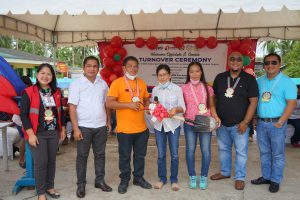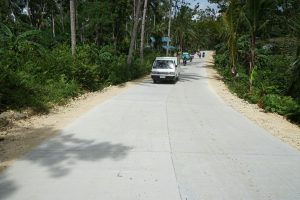Returned families affected by the pandemic who benefitted from the Balik Probinsya, Bagong Pag-asa Program (BP2P) of the Department of Social Welfare and Development (DSWD) helped the municipality of San Isidro with a grant to fund an identified need.
Through the Kapangyarihan at Kaunlaran sa Barangay (KKB) modality of the Kapit-Bisig Laban sa Kahirapan Comprehensive and Integrated Delivery of Social Services (KALAHI-CIDSS), local government units (LGUs) with at least 20 returning or returned families are to receive a Php 7.5 million grant to create a rural development in areas where BP2P families are reintegrated.

San Isidro, a fifth-class municipality in Bohol, is one of the recipients of the grant to develop a 0.632 km access road in Barangay Cansague Norte, where it can benefit at least three barangays. Common problems in the community are the rough road conditions that make it difficult for students to reach school; farmers to deliver their products to the town’s market; and the danger it poses for commuters.
On August 24, 2022, the barangay community, through a turnover ceremony, finally received the completed sub-project. It was led by the Training Specialist IV of KALAHI-CIDSS Maribeth A. Cabalda together with the Barangay/Municipal Local Officials and representatives of the Provincial Local Government Unit and 2nd congressional district of the province.
During the ceremony, Cabalda recognized the aspirations of volunteers and the result of the BP2P beneficiaries’ decision to come home. “Today is a memorable day for all of us as this marks the fulfillment and actualization of the long-awaited dream for community development. Not all communities receive the same privilege to implement the program of DSWD, but here, your volunteers through the Barangay Development Council-Technical Working Group (BDC-TWG) and the participation of BP2P beneficiaries are able to do it,” she said.
The community-based program that KALAHI-CIDSS advocates have given the people in Cansague Norte the chance to participate in working on sub-projects that will respond to their needs. It employs a principle that helps community members decide and participate in development in exchange for a sub-project.
“Ang proyekto nga atong nadawat kay bunga sa sakripisyo sa mga boluntir sa ilang pagsulbad sa problema sa komunidad. Uhaw pa kita sa mga proyekto apan nakita nato nga nitubo ang gamut sa ilang pagpaningkamot (The project that we received is the result of the sacrifice of our volunteers in solving the problem in the community. We are still hungry for more, but we have seen the roots of their efforts grow), said Vice-Mayor Filemon R. Montabote.
For many in Cansague Norte, the KALAHI-CIDSS road is considered one of the biggest projects they received. This pushed some members of the community to cooperate and volunteer willingly, even without compensation. They know that the implementation process is tedious, but they did not lose hope of completing it. They put in the effort because they saw what was at stake: a benefit for all.
Joel Ragas, a volunteer for the Project Implementation Team, shared how his admiration for KALAHI-CIDSS grew. He said “Tinuod lisod ang trabaho sa KALAHI apan ang pamaagi nga hapsay ug matinud-anon ang nakanindot sa maong programa. Bisan pa man adunay mga panahon nga nakasugat mi og problema apan nasulbad namo kini pinaagi sa pagtinabangay ug anaa pud ang mga staff sa programa nga mi-giya kanamo. Tungod niini, nagkatapok ta dinhi karon aron masaksihan ang bunga sa among pagpaningkamot (It is true that working for KALAHI is difficult, but the smooth and truthful process of the program is good. Even though there were times that we faced challenges, we were able to solve them through the cooperation of everybody and with guidance from the program staff. Because of that, we are all gathered here today to witness the fruit of our sacrifices),” he shared.

DSWD hopes that through this project, economic opportunities will start to flourish and people will sustain the kind of participation that they have generously shared with the program.
The Cansague Norte is a testament to how the program has contributed to human development in areas where it serves, transforming the way people think towards helping achieve a common goal.
In a statement of the municipal mayor, he thanked KALAHI-CIDSS and shared his vision for his town. “Dako kaayo og natabang ang KALAHI-CIDSS diri kanamo. Ang pag-ugmad sa among komunidad nagsugod og mokonekta kini sa tanang barangay dinhi sa among lungsod. Maayo unta ug taas ang paingnan sa hinagoan nga natampo sa atoang mga boluntir (KALAHI-CIDSS has given us big help. The development of our community started and it will connect to all the barangays in our town),” said the local chief executive.
Municipal local officials and congressional representatives vowed to support the program in the sustainability and institutionalization efforts of the program so that more communities can also experience what Cansague Norte has experienced with KALAHI-CIDSS.
For people in San Isidro, community-based sub-projects have changed the image of their town and helped them envision what’s best for them. With KALAHI-CIDSS, the dream of growing a network of developments bears fruit because of the cooperation of the community and BP2P families to start anew. ###
(2516) Views